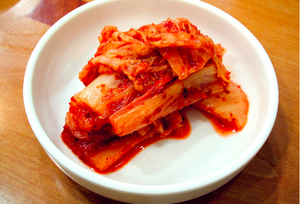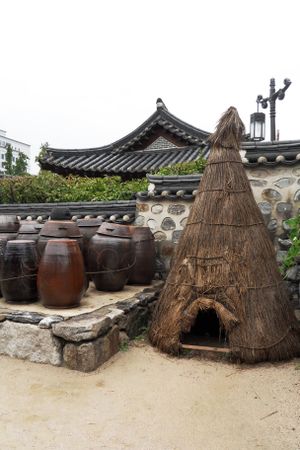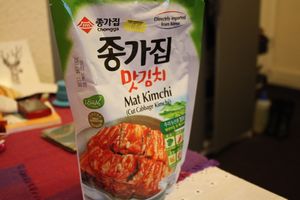Course:FNH200/2012w Team18 Kimchi

Originated from Korea, kimchi (침채) is a classic fermented dish often served as a side dish but can also be served on its own. It is considered the national food of Korea. Kimchi is made from pickling vegetables and fermenting it for a period of time. There are hundreds of different types of kimchi using various vegetables but the most common kimchi (baechu kimchi) is made using cabbage, chili pepper, garlic and fish sauce. Other commonly used vegetables are chives, radish and cucumbers. [1] Kimchi has become an important aspect in Korean cuisine.
Introduction
How to make Kimchi
Etymology
Kimchi is the most common English spelling but can also be spelt as kimchee, gimchee, gimchi, gim chi [2]. The origin of the word kimchi is unknown but may either be derived from the Korean word ji or jimchae, which means vegetable soaked in salted water or from the Korean pronunciation of the Chinese term ham-tse or kam-tse meaning salted water or picked vegetable. [3]
History
Kimchi can be traced back to the Three Kingdom period (3rd Century). Vegetables were unable to grow in the harsh cold Korean winters and therefore a method was needed to preserve them during these harsh conditions.[4] They started preserving their vegetables by pickling and fermenting them since vegetable agriculture and horticulture was ancient Korea's main industry. More specifically, preserving vegetables for kimchi was a sufficient way of using the over abundance of cabbage available in the region, which also provided food security for the Korean people. Kimchi back then was very different than the current modern kimchi we are familiar with. During the Goryeo (also known as Koryo) period (10th Century) there were 2 main types of kimchi: jangajji, which is made of sliced raddish preserved in soy sauce and sammu sogeumjeori, which is essentially salted raddish. [5][6] In the Joseon period (17th Century), the Japanese invaded Korea, bringing along hot red chili pepper flakes with them. This ultimately led to the incorporation of hot chili pepper flakes into the dish; which gives the kimchi its distinct red color.[7]
Nutrition Facts & Health Benefits
Nutrition Facts
Kimchi is considered to be healthy because it is made from fresh vegetables. Every 100g of kimchi contains 16kcal, allowing for a higher daily intake. Since Kimchi is always made from vegetables and does not contain any meat and oil, it has a high water content and is low in cholesterol, protein and fat. The vegetables in kimchi are also high in fibre and contains many types of minerals and vitamins that are essential for humans. [8]
Below is the nutritional table of kimchi (per 100g) [9]
| Subject | Cabbage |
|---|---|
| Calories (kcal) | 16 |
| Water (%) | 94.7 |
| Protein (g) | 1.3 |
| Fat (g) | 0.2 |
| Sugar (g) | 2.4 |
| Fiber (g) | 1.7 |
| Minerals (mg) | 0.5 |
| Calcium (mg) | 70 |
| Phosphorus (mg) | 63 |
| Iron (mg) | 0.3 |
| Vitamin A (R.E.) | 225 |
| Vitamin B1 (mg) | 0.06 |
| Vitamin B2 (mg) | 0.09 |
| Niacin (mg) | 0.4 |
| Vitamin C (mg) | 28 |
Health Benefits

Kimchi is believed to have many health benefits. The major health benefit of kimchi is its anti-biotic function. Kimchi contains lactic acid bacteria that is formed during the fermentation process. The lactic acid bateria strengthens the immune system by suppressing the growth of harmful bacteria; helping improve digestion and relieving intestinal disorders. Lactic acid bateria also helps in preventing excessive fermentation by restraining the growth of different bacterias in the intestines. In addition to lactic acid bacteria's anti-biotic function, it also gives matured kimchi its sour flavour. Some believe that it can also help prevent diseases, such as obesity, diabetes, and certain cancers (e.g. gastrointestinal cancer), but this has not yet been supported by scientific research.
Other health benefits include:
- Vegetable juices and the salt in the kimchi help cleanse the intestinal wall.
- Increases the secretion of protein-digesting enzyme, pepsin, which helps with protein digestion in the body. [9]
- Red chili pepper and garlic assist in lowering blood cholesterol and prevents blood clotting. [8]
Categories of Kimchi & Kimchi Dishes

There are over 100 different types of Kimchi. Kimchi is categorized by the location and the timing of its production. A favorite recipe from a family or a particular region would be passed on through the generations, using ingredients grown in their region that grow in their natural weather conditions. For example, it is known that North Korean Kimchi is less salty, less spicy and fresher tasting while South Korean Kimchi is saltier, spicier and more flavorful. Different types of Kimchi are made in different seasons of the year. Seasonal Kimchi is made during the spring, summer and fall seasons using vegetables that are in season. Winter Kimchi is made in huge batches near the end of fall intended to last the entire winter season until vegetables were available again in the spring. Types of seasonal kimchi include Young cabbage Kimchi, and Sliced Radish Kimchi, popular in the spring. Sliced radish kimchi is made with large white radish (daikon). In the summer time, Cucumber Kimchi (Oi Sobagi) and baby radish Kimchi (Yolmu Kimchi) are the most popular. Cucumber Kimchi is cool, crispy, and it can be eaten fresh or after fermentation. Baby radish Kimchi is crispy, sweet, and spicy. Different types of Winter Kimchi include whole cabbage Kimchi (tongbaechu Kimchi) which is the most popular type of Kimchi made with Chinese cabbage, Napa cabbage or celery cabbage, Whole radish Kimchi (Tongchimi Kimchi) which is made with large white radishes (daikon), and ponytail Kimchi (Chonggak Kimchi) which is made with pony-tail radishes.[10] [11]


Among the hundred types of Kimchi, these 8 types are the most popular:
- Baechu Kimchi (whole cabbage Kimchi) – originated from Seoul, whole cabbage Kimchi is one of the most popular in Korea.
- Baek Kimchi (white Kimchi) – is seasoned using ginger and garlic strips wrapped in cheesecloth, and red pepper threads.
- Bossam Kimchi (Wrapped-up Kimchi) – a varieties of seafood, vegetables, fruits and nuts wrapped in cabbage leaves.
- KKaktugi Kimchi (Cubed radish Kimchi) – one of the most popular types of Kimchi in Korea. Has a crunchy, refreshing texture.
- Oi Sobagi (cucumber Kimchi) – Crunchy, crispy and cool texture and it is popular during the cucumber season.
- Chonggak Kimchi (pony-tail Kimchi) – prepared with red pepper powder and anchovy juice
- Dongchimi (radish water Kimchi) – a water-based Kimchi made with white radish without the use of red peppers.
- Yolmu mul Kimchi (young radish water Kimchi)
Even though Kimchi is mainly eaten as a side dish, it can also be used as an ingredient in many Korean dishes. A few examples include: Kimchi stews, Kimchi pancakes, and Kimchi fried rice.
Microorganisms
There are five major types of microorganisms in Kimchi fermentation process:
Lactobacillus Plantarum
Lactobacillus plantarum is one of the most common species of lactic acid bacteria found in many fermented food products and often used as a starter culture in vegetable fermentations.[12] As a facultative heterofermentative bacterium, its main function during fermentation is the conversion of sugars present in raw materials into lactic acid. For example, it is able to degrade cassava raw starch and produce lactic acid. [13] Also, it has the ability to adapt and thrive in a range of environments. Additionally, L. plantarum is frequently encountered as a natural inhabitant of the human gastrointestinal (GI) tract. There is a selected strain, named L. plantarum 299v, is marketed as probiotic that may confer several beneficial effects to consumers.[14] Besides present in Kimchi production, L.plantarum is also a common "good" bacterium in other fermented food products such as sauerkrayt, pickles, and cheese.
Lactobacillus Brevis
Lactobacillus brevis, which is heterofermentative gram-positive, is another species of lactic acid bacteria. It is able to ferment hexose sugars to produce lactic acid, which provides a low pH condition and helps preserve our Kimchi for a longer shelf life. The optimal temperature condition for its activity is around 37°C. [15] Along with other lactic acid-producing bacteria, L. brevis plays an integral role in the fermented foods. Lactobacillus brevis can be isolated from the food sources in inhabits, especially from Kimchi.[16]
Enterococcus Faecalis
Enterococcus Faecalis, which is a type of gram-positive bacteria found in soil, water, and plants, can survive harsh conditions in nature. To be specific, it can grow at a temperature range of 10 – 12°C and in environment with broad pH values. Therefore, it can also be present in Kimchi fermentation, although not as common as the two types of bacteria above. From scientific studies on Enterococcus Faecalis for possible use as a probiotic, the evidence has shown that it tends to reduce the risk of diarrhea. [17]
Leuconostoc Mesenteroides
Traditionally, Leuconostoc Mesenteroide was found in association with plant matter, fermenting vegetables, milk, dairy products, and wines. In general, it is a type of nonpathogenic acid-tolerant microorganisms with optimal temperature 18 – 25°C. This group of bacteria is very diverse. One common bacterium named L. carnosum is anaerobic and able to inhibit growth of other bacteria; thus, it can be used as bio-preservative. [18] The same feature with other lactic acid bacteria is that it helps promote fermenting sugars in food products to lactic acid.
Pediococcus Pentosaceus
Pediococcus pentosaceus are also categorized as a kind of lactic acid bacteria. They can be cultured at 35 – 40°C but are unable to grow at 50°C. The appropriate pH range for their growth is 4.5 – 8.0; while they grow more stably at the more acidic pH range. Besides the importance on fermenting foods, Pediococcus pentosaceus can produce a special bacteriocin, which can be used as a food preservative to inhibit gram-positive microbes. [19]
Fermentation Process

Lactic acid, bacteria, and enzymes found naturally in the raw kimchi ingredients are essential compounds that initiate the fermentation process.[20] Lactic acid helps the maturation process of the kimchi, while enzymes work in conjunction with the organic elements found naturally in the vegetables to prevent spoilage. [21] Temperature and salt affects how long the kimchi needs to mature.[20] The higher the temperature, the faster the kimichi will mature.[21] Kimchi is most flavourful when fermented in temperatures between 5-10°C. The salt concentration for summer and winter kimchi are different; 2-3% for the winter kimchi, and 4-5% for the summer kimchi. Salt extends the longevity of the kimchi fermentation process by controlling the osmotic pressure. Salt causes the osmotic pressure to increase, causing the vegetables to dehydrate and soften.[20] The change in the osmotic pressure slows down the bacterial and enzyme activity of harmful bacteria drastically and helps the kimchi mature. As the vegetable continue to dehydrate, necessary bacteria and enzymes are produced and contribute to the overall taste and smell of kimchi. [21] In commercial application, a phenomenon known as the phenomenon of over maturation may occur. During the late stages of fermentation, the enzyme polygalactulonaze decomposes pectin which softens the kimchi fibres. As kimchi continues to ferment and mature, kimchi juices are produced. The kimchi juices cause a rapid increase of polygalactulonaze which overly decomposes the pectin causing the kimchi to over ripen. This over-maturation causes problems to the storage and distribution stages, therefore these stages need to be closely monitored.[21]
The different stages during kimchi fermentation are based on the change of pH, acidity, and reducing sugar content.[22] During fermentation, there is an increase in lactic acid and acetic acid, which changes the acidity and pH of the kimchi. Kimchi fermented at low temperatures, such as 6-7°C will contain more lactic and succinic acid. If the mixture has a high salt concentration, it will lower the amount of acetic acid; however, having large amounts of acetic acid and carbon dioxide makes the kimchi taste better. [22] During the first stage, there is a rapid decrease of pH, an increase of acidity and a decrease of reducing sugar. In the second stage, the pH continues to gradually decrease, the acidity continues to increase, and the reducing sugar begins to decrease more rapidly. The last stage exhibits either a gradual changes or no change at all in pH, acidity, and reducing sugars.[22] Overall, the acidity of the kimchi increases, while the pH and the reducing sugars content decreases. The kimchi begins at an initial pH between 5.5-6.0 and drops down to 4.5-4.2 during the ripening period and continue to further decrease during the over-maturation period.
Storage & Packaging

Kimchi storage is essentially separated into two main methods; contemporary and traditional. Traditional storage involves the use of large clay pots that are fermented underground, which provides a cool and constant temperature for storage. Although underground storage is typically used in traditional methods, it is necessary for fermentation conditions to be held at a constant and cool temperature [23]. In contemporary kimchi storage, vegetables are typically fermented in large jars or containers, rather than clay pots that are used in more traditional methods. The fermentation process in contemporary methods can be stored at room temperature or in refrigerators for anywhere from a few hours to a few weeks [23]. During the fermentation process it is crucial to keep a tight seal so that no oxygen enters the jar or container. The addition of oxygen will create carbon dioxide gas, which will give the kimchi a bubbly taste. Once opened, kimchi can be stored for up to a month. Another significant characteristic of contemporary kimchi storage is the use of a kimchi refrigerator. Popularized and made specifically in Korea, the kimchi refrigerator is an appliance designed to meet storage and temperature requirements for various types of kimchi [24]. The concept of the kimchi refrigerator was introduced in 1995 and from then-on sales has skyrocketed; from 5,000 units being sold in its first year in the market to 530,000 units sold in 1999 [24]. All of which were exclusive to Korea. It is estimated that 81% of Korean households have a kimchi refrigerator [24]. While the market was substantially limited in the beginning, companies like Samsung and LG Electronics have started to produce their own versions of kimchi refrigerators. Kimchi refrigerators adopted a direct cooling system, unlike conventional refrigerators which use an indirect cooling system, because direct cooling systems maintain constant temperature and humidity [24].

When packaging Kimchi, there are various methods and types. The most consistent and effective method is vacuum packaging; this involves sealing the given Kimchi product by sucking all the oxygen out [25]. This process prevents oxidation, mould growth, and dampening and also keeps products fresh so that they are able to be stored for prolonged periods of time [25]. Although vacuum sealing is the most effective method of packaging Kimchi, Kimchi products are also packaged in packets, bags with bottom gussets, and canned in tins. Kimchi packaging is generally used by companies who sell Kimchi-based products, whereas most Korean families typically prepare their own. Since Kimchi is comprised of fermenting vegetables, it is essential that these companies that distribute and sell Kimchi-based products adequately package and seal their products in order to avoid the growth of microorganisms, oxidation, dampening, and contain the distinct smell Kimchi frequently brings about [25].
Exam Question
Question: What acid is essential for kimchi fermentation and what role does it play?
Answer: Lactic acid. It suppresses the growth of other bacteria in Kimchi
References
- ↑ Naomi, I.Y. Kimchi. Retrieved from http://koreanfood.about.com/od/glossary/g/Kimchi.htm
- ↑ Kimchi. Retrieved from http://koreanfood.about.com/od/glossary/g/Kimchi.htm
- ↑ The Origin of Kimchi. Retrieved from http://www.lifeinkorea.com/culture/kimchi/kimchi.cfm?xurl=origin
- ↑ Kimchi. Retrieved from http://foodreference.about.com/od/traditional_foods/a/Kimchi.htm
- ↑ http://english.visitkorea.or.kr/enu/fo/fo_en_6_1_2_1.jsp. (n.d.). Retrieved from Official site of Korea: History of Kimchi
- ↑ The Complete guide to Kimchi. Retrieved from http://seoulistic.com/korean-food/a-complete-guide-to-kimchi/
- ↑ What is Kimchi/Kimchee? Retrieved from http://ilovekimchi.org/
- ↑ Jump up to: 8.0 8.1 Life in korea kimchi;s nutrition. (n.d.). Retrieved from http://www.lifeinkorea.com/culture/kimchi/kimchi.cfm?xURL=nutrition
- ↑ Jump up to: 9.0 9.1 Official site of korea tourism org.: Nutrition value. (n.d.). Retrieved from http://english.visitkorea.or.kr/enu/FO/FO_EN_6_1_2_2.jsp
- ↑ Types of kimchi. (2013). Retrieved from http://ilovekimchi.org
- ↑ Korean kimchi. (2013). Retrieved from http://www.easykoreanfood.com/kimchi.html
- ↑ Knochaert, D.; et al. (2012). Metabolism of Ferulic Acid During Growth of Lactobacillus Plantarum and Lactobacillus Collinoids. Journal of the Science of Food and Agriculture. 92 (11): 2291 – 2296.
- ↑ Lactobacillus plantarum. Retrieved from http://microbewiki.kenyon.edu/index.php/Lactobacillus_plantarum.
- ↑ Kleerebezem, M.; et al. (2003). "Complete genome sequence of Lactobacillus plantarum WCFS1". Proceedings of the National Academy of Sciences of the United States of America. 100 (4): 1990–1995.
- ↑ Lactobacillus brevis. Retrieved from http://microbewiki.kenyon.edu/index.php/Lactobacillus_brevis.
- ↑ Ronka, E.; et al. (2003). Probiotic and Milk Technological Properties of Lactobacillus Brevis. International Journal of Food Microbiology. 83 (1): 63 – 64.
- ↑ Enterococcus Faecalis. Retrieved from http://microbewiki.kenyon.edu/index.php/Enterococcus_faecalis.
- ↑ Leuconostoc Mesenteroides. Retrieved from http://microbewiki.kenyon.edu/index.php/Leuconostoc.
- ↑ Pediococcus Pentosaceus. Retrieved from http://microbewiki.kenyon.edu/index.php/Pediococcus_pentosaceus.
- ↑ Jump up to: 20.0 20.1 20.2 Making & Storing Kimchi. Retrieved from http://ilovekimchi.org/learn-about-kimchi/kimchi-making-storing/
- ↑ Jump up to: 21.0 21.1 21.2 21.3 Kimchi. Retrieved from http://www.kuksuldo.com/kimchi.htm
- ↑ Jump up to: 23.0 23.1 Visit Korea. Retrieved from http://english.visitkorea.or.kr/enu/SH/whatToBuy/whatToBuy.jsp?action=item&cid=995700
- ↑ Jump up to: 24.0 24.1 24.2 24.3 Yoon, J.Y. Kimchi Refrigerator Maintains Taste of Fermented Food. Retrieved from https://www.koreatimes.co.kr/www/news/tech/2013/01/133_99236.html
- ↑ Jump up to: 25.0 25.1 25.2 Kimchi Vacuum Packing Machine. Retrieved from http://shhuihe.en.alibaba.com/product/483097879-212666777/DZ400_500_Kimchi_Vacuum_Packing_Machine.html